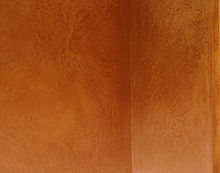Tadelakt

| Part of a series on |
| Arabic culture |
|---|
 |
Tadelakt (
Etymology and history
The term tadelakt, meaning "to rub in", is an Amazighified expression from the Arabic word تدليك tadlīk, meaning "to rub or massage."[3][4]
Tadelakt is thought to have evolved from qadad, a similar plaster used in Yemen for millennia that is treated with calcium hydroxide and oils and fats instead of soaps.[2]
Constituents and chemistry
The basic constituents of tadelakt plaster are:
- lime plaster (not Portland cement)
- in some cases, marble or limestone sand (but not other aggregates)
- natural soap (often "black" or olive oil soap) to speed carbonation of the surface and impart water-resistance.
The soap chemically reacts with the lime plaster, forming lime (calcium) soaps. Calcium soaps are insoluble in water,[5] and fairly hard.[3] They are familiar, in areas with calcium-rich ("hard") water, as deposits in bathtubs, sinks, and showers; when soap is mixed with the water's dissolved calcium carbonate/lime, calcium soaps form.
- 2 C17H35COO−Na+ + Ca2+ → (C17H35COO)2Ca + 2 Na+
Techniques

Traditional application includes polishing with a river stone and treatment with oleic acid, in the form of olive oil soap, to lend it its final appearance and water resistance.
In Morocco, the traditional application technique:
- plaster powder is mixed with water for 12 to 15 hours prior to the addition of pigment.
- the plaster is applied in one thick coat with a wooden float, and smoothed with the same.
- before the plaster sets, a flat, smooth, hard stone is used to compress the plaster, then a plastic trowel used for the final polish.
- it is mechanically polished using stones or abrasives harder than the plaster, providing a smooth, sometimes shiny, finish.
- lastly, an olive-oil soap solution is used to seal the plaster
Long-term maintenance of tadelakt requires regularly re-sealing the surface with a soap solution;[3] in the case of qadad roofs, this was traditionally done every few years.[2]
Uses

Tadelakt is the traditional coating of the hammams and bathrooms of palaces and riad residences in Morocco.[6] The restoration of riads in Morocco has led to a resurgence in its use.[citation needed]
In modern times, it has been used outside.[7]
See also
- Earthen plaster
- Polished plaster
- Plasterwork
- Sarooj, a similar water-resistant plaster
- Zellige
- Stucco
References
- S2CID 109703139.
- ^ a b c Anita Sutter, « Note sur la fabrication du qadâd », Chroniques yéménites [En ligne], 6-7 | 1999, mis en ligne le 18 décembre 2006, consulté le 13 février 2016. URL : http://cy.revues.org/111
- ^ ISBN 9781551434827– via Google Books.
- ^ Team, Almaany. "تعريف و شرح و معنى تدليك بالعربي في معاجم اللغة العربية معجم المعاني الجامع، المعجم الوسيط ،اللغة العربية المعاصر ،الرائد ،لسان العرب ،القاموس المحيط - معجم عربي عربي صفحة 1". www.almaany.com. Retrieved 2019-05-11.
- S2CID 19412236.
- S2CID 109014106.
- ^ "Tadelakt Exterior stucco Vancouver - Venetian Plaster and Stucco - Vancouver BC". authenticplasterfx.com.
External links
 Media related to Tadelakt at Wikimedia Commons
Media related to Tadelakt at Wikimedia Commons

